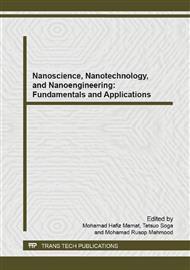[1]
J. Rouhi, S.D. Hutagalung, S. Kakooei, S. Mahmud, Fabrication of nanogap electrodes via nano-oxidation mask by scanning probe microscopy nanolithography, Journal of Micro/Nanolithography, MEMS, and MOEMS, 10 (2011) 043002-043003.
DOI: 10.1117/1.3643480
Google Scholar
[2]
J. Rouhi, M.R. Mahmood, S. Mahmud, R. Dalvand, The effect of emitter geometry on lateral field emission diodes fabricated by AFM-based electrochemical nanolithography, Journal of Solid State Electrochemistry, 18 (2014) 1695-1700.
DOI: 10.1007/s10008-014-2403-5
Google Scholar
[3]
J. Rouhi, S. Mahmud, S. Hutagalung, N. Naderi, Field emission in lateral silicon diode fabricated by atomic force microscopy lithography, Electronics letters, 48 (2012) 712-714.
DOI: 10.1049/el.2012.1020
Google Scholar
[4]
N. -H. Kim, M. -H. Choi, S. -Y. Kim, E. -G. Chang, Design of experiment (DOE) method considering interaction effect of process parameters for optimization of copper chemical mechanical polishing (CMP) process, Microelectronic Engineering, 83 (2006).
DOI: 10.1016/j.mee.2005.11.016
Google Scholar
[5]
A.I. Khuri, S. Mukhopadhyay, Response surface methodology, Wiley Interdisciplinary Reviews: Computational Statistics, 2 (2010) 128-149.
DOI: 10.1002/wics.73
Google Scholar
[6]
K. Eswar, J. Rouhi, F. Husairi, R. Dalvand, S.A. Alrokayan, H.A. Khan, M. Rusop Mahmood, S. Abdullah, Hydrothermal growth of flower-like ZnO nanostructures on porous silicon substrate, Journal of Molecular Structure, (2014).
DOI: 10.1016/j.molstruc.2014.05.067
Google Scholar
[7]
J. Rouhi, S. Mahmud, N. Naderi, C.R. Ooi, M.R. Mahmood, Physical properties of fish gelatin-based bio-nanocomposite films incorporated with ZnO nanorods, Nanoscale research letters, 8 (2013) 1-6.
DOI: 10.1186/1556-276x-8-364
Google Scholar
[8]
K. Eswar, J. Rouhi, H. Husairi, M. Rusop, S. Abdullah, Annealing heat treatment of ZnO nanoparticles grown on porous Si substrate using spin-coating method, Advances in Materials Science and Engineering, 2014 (2014) 6.
DOI: 10.1155/2014/796759
Google Scholar
[9]
M. Husairi, J. Rouhi, K. Alvin, Z. Atikah, M. Rusop, S. Abdullah, Developing high-sensitivity ethanol liquid sensors based on ZnO/porous Si nanostructure surfaces using an electrochemical impedance technique, Semiconductor Science and Technology, 29 (2014).
DOI: 10.1088/0268-1242/29/7/075015
Google Scholar
[10]
S. Masubuchi, M. Ono, K. Yoshida, K. Hirakawa, T. Machida, Fabrication of graphene nanoribbon by local anodic oxidation lithography using atomic force microscope, Applied Physics Letters, 94 (2009) 082107.
DOI: 10.1063/1.3089693
Google Scholar
[11]
N. Naderi, M. Hashim, J. Rouhi, H. Mahmodi, Enhanced optical and electrical stability of thermally carbonized porous silicon, Materials Science in Semiconductor Processing, 16 (2013) 542-546.
DOI: 10.1016/j.mssp.2012.09.010
Google Scholar
[12]
J. Rouhi, M. Alimanesh, S. Mahmud, R.A. Dalvand, C.H.R. Ooi, M. Rusop, Optical properties of well-aligned ZnO nanostructure arrays synthesized by an electric field-assisted aqueous solution method, Ceramics International, 40 (2014) 11193–11198.
DOI: 10.1016/j.ceramint.2014.03.157
Google Scholar
[13]
J. Rouhi, S. Mahmud, S.D. Hutagalung, S. Kakooei, Optimisation of nanooxide mask fabricated by atomic force microscopy nanolithography: a response surface methodology application, Micro & Nano Letters, IET, 7 (2012) 325-328.
DOI: 10.1049/mnl.2011.0658
Google Scholar


